Final Notes on Combined Mission
To Montaña de la Flor
|
Groups Involved: |
Mission Honduras LeMars
Joint Task Force Bravo
South Dakota State University
Honduras Ministry of Health |
6 February 2011
Dick. It’s a nice Sunday morning here in Tegucigalpa. It will be another
warm day, much different than you describe in the Midwest. Well, Dick, here
is another report on the mission trip to la Montaña de la Flor with JTFB
(Joint Task Force Bravo, Soto Cano, Honduras), SDSU (South Dakota State
University, Brookings, S.D.), the Honduran military and members from the
Honduras Ministry of Health (MoH) and others. (Task Force
Bravo/Health
Initiative)
|
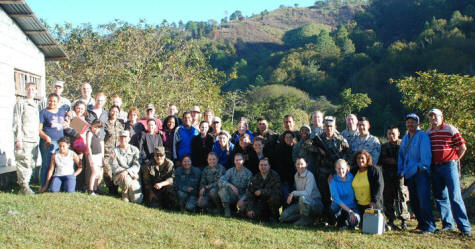 |
Before I begin this last report to you I must say that Mission Honduras
LeMars, its board of directors and all those people that support it, can be
very proud of everything that was accomplished on this trip. You all would
be proud of Dr. Teri Kemmer and her team of students from South Dakota State
University, Brookings, S.D. You would also be proud of Dr. Miguel Coello
and the entire U.S. military and Honduras military contingent from Joint
Task Force Bravo. These people were absolutely amazing along with all those
from the Honduras Ministry of Health. A very special thank you as well to
all our Honduras’ friends who made this a top priority in their lives, if
only for a few days: from the Passionists, who translated, to our cooks and
drivers. The very important results of what this team did could not have
been accomplished without everyone’s help and cooperation. As the only
representative from Mission Honduras LeMars with the team in the mountain, I
want to extend my thanks to everyone.
|
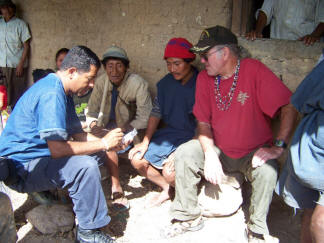 |
|
Julio Rivera (eldest Tolupan son of Chief Tomas), Angel Paz (water engineer)
and I returned from MDLF on Saturday 22 February after transporting more
supplies and materials to MDLF. We left Angel in La Esperanza where his
motorcycle was parked. On Monday 24 January Julio and I did more shopping
for specific supplies, food and others. Julio left early on Wednesday
morning to travel to Sulaco. He took various items with him. On Thursday
27 January he would travel to MDLF with Dulce (chief cook), her daughters
and granddaughter. Also along was Jorge, who would help translate. They
would be carrying the big stove we bought for Dulce a few years ago. The
other 2 smaller stoves are already in MDLF. They would stop in Acote to buy
chicken, rice, eggs and much more. We would also need to buy more food on
Saturday at the open market in la Ceiba, MDLF.
I was at the airport to meet Dr. Teri Kemmer (U.S. Army retired – now a
professor in ‘Nutrition’) and her team from SDSU. One of the team members
had visa troubles and was not permitted to fly from Omaha. Her team was 6
members. Dr. Miguel Coello and Dr. Jenny (first name) were also there
along with personnel from JTFB who would transport her team and other
arriving U.S. military personnel to Soto Cano. They would spend Thursday 27
January sorting items, doing inventory, etc., in preparation for the flights
on 28 January to MDLF.
I drove to Talanga to meet Angel and the Passionists’ volunteers that would
help translate during the mission. Carlos from SPS (San Pedro Sula) was
also there with the van I had hired to help transport the various teams. We
were worried because the van was really low to the ground. It was big
enough, but…we would have trouble later. We left Talanga about 10:30 in the
morning. After a brief lunch in Dona Blaca’s village (La Esperanza) we
headed over the mountains to Acote. I had picked up Fausto Andino (English
teacher) in El Guante. My truck was loaded and full of food, supplies,
etc. I could only carry Fausto. He would miss the first couple days of the
new school year, but he said this was important. We have been taking a
different route from this area because the roads are so bad south of Orica
and the heavy loads we have been carrying. It was a 1 hour 15 minute ride
to Acote. I confirmed Julio and Dulce had bought food, etc. We switched
some of the supplies from my truck to the van so we could carry people in
the truck box to MDLF. We could not carry all of them. It was sad. A very
large family had to be left to walk.
Following the van, I was worried it would not get to MDLF. We had put extra
weight in the van so we could carry people in our truck. The road is being
fixed by the coffee association so they can get the large trucks loaded with
coffee off the mountain. Carlos had a lot of trouble getting through some
of the deep ruts and bumps, but in the end did make it to la Ceiba. We
would continue to have trouble with transporting the various teams with the
van, but if it was not loaded heavily, Carlos could get it done. In the
end, I decided to see if the owner would switch the van for a land cruiser
for about the same price, but he refused. I sent the van back to SPS after
only four days. It just could not get high and especially all the trips we
made to La Lima. Marny’s (Rivera) father Raul had donated his truck for my
use during this mission, and we also had our truck.
We arrived on 27 January and Dulce and team had already had most of the
kitchen area set-up. We set-up the generators, lights, cords, etc. for the
JTFB team which would arrive on Friday 28 January. We had a nice meal and
went to bed early. It was a long day, but they would get longer.
Friday started off with cloudy and overcast skies, but thankfully no rain.
It was windy. I also want to say that Marta Sosa from Cerro de Plata was
successful in getting a truck and driver donated for this mission. The
organization Unidad de Exencion de Cobertera y Finansa (UECF) donated the
truck and driver. His name was David, and he would become a valuable
contribution to the team. He would bring Dr. Cruz from the MoH’s department
of Nutrition to MDLF on Saturday 29 January and then return her to
Tegucigalpa late Saturday and then return to MDLF on Sunday and stay until
the mission was completed. Dr. Cruz worked with one of the teams on
Saturday. Dr. Coello said it was very unusual for such a person of her
stature to take a trip like this on a Saturday. I hope to meet with her
later in the month with Marta from Cerro de Plata and talk more about the
Plumpy Nut (the special food purchased by Mission Honduras LeMars, from the
Edesia Co. in Providence, Rhode Island, used primarily with severely
malnourished children). It had rained fairly heavily Friday night so the
roads were slippery on Saturday as we all headed out on the mission. We had
4 trucks the 1st day. We could not get to La Lima, which is over
5,000 ft. high, so the mission had to be changed. We would get to La Lima
the next 2 days.
Dr. Coello had told me on 27 January that the 1st Blackhawk
helicopter should lift off from Soto Cano about 9 a.m. on Friday. It would
be about a 30-minute flight. We were all in position at 9 a.m., but no
helicopters. Many people were standing and sitting around waiting to watch
the helicopters land. I was getting worried; it was 10:30 and no
helicopters. About 5 minutes later the police arrived and then 2 military
intelligence officers arrived. They told me that the San Pedro Sula area
had heavy rains the night before and that the Soto Cano valley had heavy fog
which forced the lift-off times for the helicopters back.
The 1st helicopter arrived about 11:10 hours. JTFB would use 2
Blackhawks and each would make 3 trips to offload personnel and supplies.
It was quite the sight to watch these helicopters come through the
mountains. The LZ (landing zone) was near the former soccer field. You can
see the area in the photos I sent.
After each helicopter flight the materials that had been offloaded had to be
taken up the hill to the community center and the other buildings. We would
use all the buildings during the mission. I know you are familiar with the
community center. We would also use the 2 school buildings to the east and
the building below the community center which was originally supposed to be
a church.
This was a large group. The total team consisted of: 16 US military
personnel (including doctors, nurses, medics, communications) 10 men, 6
women; 5 Honduras’ military security; 5 Honduran doctors (3 military and 2
civilian) of which 3 were women and 2 were men; Dr. Kemmer’s team had 6
members; I brought 8 translators and, of course, Julio and I; and with Dulce
and her family that added 4 more. Dr. Alveraz from the clinic in Orica and
2 or 3 staff members also were with us most days. Cecilia and Edgar from
the health center in San Juan were also with us. Obviously, it was very
crowded at night.
The sleeping arrangements were: The men from the military and a few other
guys would all stay in the building below the center. JTFB provided cots
for their people. The military women and Honduran doctors would sleep on
cots in the building where we always had the dental clinic. Dulce, Dr.
Kemmer and the women from SDSU would sleep in the center. Those from JTFB
had cots. The translators and others would sleep on mattresses from Mission
Honduras LeMars. MHL provided pillows, blankets, sheets, towels to all
except those from JTFB. I also had to provide these same items for the
Honduran military security since these items were not packed at JTFB.
Angel, Fausto, and I slept in the eastern most school. Julio slept in the
pharmacy area.
We would typically sleep 46-48 people every night. I had 2 generators
set-up that provided power to these buildings, although I only had so many
lights, but all worked well. We would ultimately use 45 gallons of gas for
the generators. We had no trouble with these generators.
The U.S. military from Soto Cano would eat MRE’s (meals ready to eat) during
their stay in MDLF (although many did join us eating Dulce’s cooked food and
coffee). JTFB brought boxes of MRE’s and hundreds of bottles of water. I
also had 15 larger bottles of water available that people could refill their
bottle if they wanted. All team members would eat MRE’s during the missions
into the villages and individual homes during the study.
On the evening of Friday 28 January a general briefing was held for all team
members, which outlined the mission for the next few days. Usually another
briefing was held in the morning and then a short sum-up briefing about the
day.
The day started at 5 a.m. when I turned the generators on. We then ate
breakfast, MRE’s, and coffee. And then the teams would leave around 7 to
7:15 each morning. We would have 3 travel days and then 1 and ½ days of
general clinic for all.
|
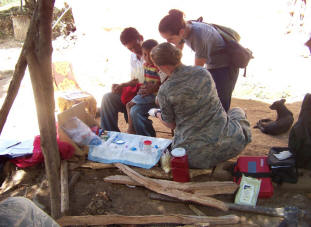
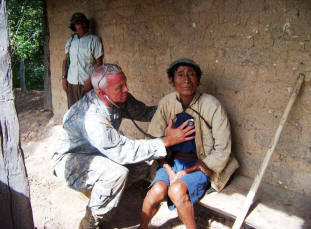 |
| |
This was the first of hopefully many future trips. As mentioned in previous
blogs, this mission was to study the nutrition of Tolupan children 6 months
to under age 5 (even if only by 1 day). The study was led by Dr. Teri
Kemmer, a PhD Nutritionist at South Dakota State University in Brooking,
South Dakota. A very detailed survey was conducted at the home or hut
site. This survey covered the family, children, income, education, access
to food, types of food eaten, lack of food, medical care, income, how many
pregnancies, how many babies died and many other questions. Each of the
homes was evaluated for type of structure, size, types of floor, type of
roof, number of rooms, how food was cooked, access to any form of latrine,
did the house have lights or water. Of course, most had neither lights nor
water, but some around San Juan did have electricity. Each team carried a
GPS. The latitude, longitude and elevation were recorded. Elevation would
be very important during the medical study of the children when looking at
hemoglobin levels.
We would have 5 teams in the field each day visiting specific homes and
children. Each team would have a translator, nurse or medic, a person to do
the survey (usually the translator) guide, a medical doctor to do a medical
evaluation. Others would also be along to help carry the gear. Each team
would have to carry a shore board (for measuring the children) and a special
backpack which would carry most of the medical equipment needed for the
study and tests. Each member would carry water and an MRE for food. We
would also have horses to help carry some of the gear. Many teams would
walk for 1-2 hours to visit a home or family, while others had shorter
walks.
Each of these teams had to be transported to an area where they could begin
the walk to the home or village. Each day we would move 40 people, and
sometimes more. It was difficult from a logistical point, but we got it
done.
The survey would cover 1 targeted child in each house. These had been
previously selected by Dr. Kemmer under some scientific manner. Each of the
targeted children would have the following tests:
1.
1. Hemoglobin using a hemocue
2.
2.
Iron level
3.
3.
Lead level
4.
4.
Zinc level
5.
5.
A hair sample that would show various growth trends
Blood filter paper would be used for most of these tests.
The targeted child would be weighed and measured for height. These would be
compared to WHO (World Health Organization) standards. A middle upper arm
circumference (MUAC) measurement would also be used and checked against WHO
standards. These standards use Z scores (either + or -) from the median to
help determine levels of malnutrition. Of course, other medical information
must also be used. The survey had very specific medical questions that the
doctors would check during the medical evaluation of the survey.
|
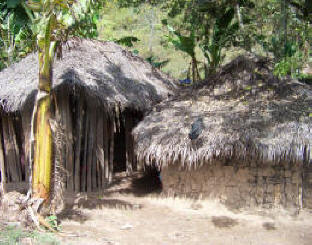
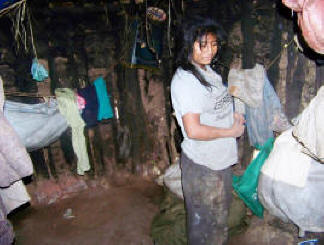 |
|
|
If other children living in the home were between the 6 months and the under
age 5 category, they also would have a hemoglobin level, height, weight and
MUAC evaluation. The mother would also have a hemoglobin level taken along
with a MUAC evaluation. Based on the study, the doctor would prescribe
medicine, like iron, etc. The family also received parasite medicine
according to standards. Each family received toothbrushes, soap, new shoes
if we had them, and in some cases specific food that team members had
brought along.
Dick, at this time I do not know how many kids received this detailed
survey. Dr. Kemmer will prepare a report and will share that with us. I
know we visited many homes and evaluated many kids.
The last day and ½ we offered the people from MDLF an opportunity to attend
a general clinic for all ages. All buildings were used (except for where I
slept) and all cots, mattresses, etc. had to be picked up or packed up each
morning for general clinic day.
The general clinic was set-up as follows:
1.
A preventative medicine clinic in the building below the center.
Here 20 or so people would be given a 15-minute or so talk about hygiene,
water, cookin, etc. This was usually done by the staff at the clinic from
Orica. It was here that they would receive vitamins, toothbrushes,
toothpaste, soap, and parasite medicine.
2.
Each person, family, etc. would then proceed to 1 or 2 triage
stations. Each station was staffed by a nurse (both were Majors), medics
and a translator. One of the triage stations had a Honduran doctor. It was
here that we received many requests for dental care. Dr. Coello and I have
been talking about this because each of our previous visits had the same
questions asked - When will a dentist come and help? I hope to talk more
with the Honduran doctors and dentists and get a team of dentists into this
area soon.
3.
From here, the patients that had children between 6 months and under
age 5 would be sent to a nutrition station. Here all kids would be weighed,
measured and have a MUAC measurement. All readings would be compared to WHO
standards. It was here that many kids got new clothes that were not
distributed from the last Gehlen Catholic Mission Honduras student trip.
They came in handy. Dr. Kemmer had brought 4 tubs of shoes she had
purchased at Wal-Mart. They also came in handy. They had also been passed
out during the survey site visits.
4.
Cecilia and Edgar from the clinic in San Juan were also there to
provide any vaccinations the kids needed.
5.
From here the patients went to the general clinic, or in some cases
to the pharmacy since the triage teams had determined they did not need to
see a doctor.
6.
The general clinic had 4 doctors with translators, if needed. 3 were
Hondurans that spoke English and the other was Col. Holein, the chief U.S.
medical doctor at JTFB.
7.
Dr. Alvarez from Orica, and Dr. Arvila did pap smears. I do not know
the number, but considering the sensitivity of the Tolupan women, they felt
this service was a great success.
8.
Some of the Plumpy Nut was used by these doctors, but since most of
the severe cases of malnutrition had been discussed with Cecilia, it was
felt that she and Edgar provide and then monitor the cases from the San Juan
clinic. Dr. Kemmer and Dr. Coello provided them with the list of patients
needing the valuable food. It was stressed that the RUF (ready to use food)
Plumpy Nut be used in addition to the child’s normal food. I think this was
understood.
The clinic treated 281 patients the 1st day and 180 the 2nd
day (good for only a half-day). Many cases were referred on to Hospital
Esquela in Tegucigalpa. I personally approved 2 cases that will need help.
Dick, I will talk about these with you another day.
The 1st helicopter was due in at 1 p.m. so we had to start moving supplies
and materials to the LZ by noon. We made many trips. Julio and his crew
packed up and headed to Sulaco. The donated truck driven by David took the
translators back through Talanga. Angel, Fausto and I left before the last
helicopter arrived. I had talked with Dr. Coello. We had a flat tire going
back and could not find someone to fix it until the next morning. We stayed
with Fausto. I had contacted all groups to make sure all had returned home
or base safely. Angel and I had the tire fixed the next morning by 6:15
a.m. We then took the supplies we had in the truck to Esquias. In Talanga
we had the truck washed and cleaned. It was very dirty. Here we found that
we had another problem with one of the tires. A steel belt had broken, and,
of course, the tire could not be fixed.
I took 3 of the volunteers from Talanga to lunch. Angel also came. They
talked about the great experience. I helped a young family that has a
2-month old baby that has deformed feet (club) and some problem with some
fingers. They did not have the $$ to get to Tegus for the appointment. I
also took them with me on my way to Tegucigalpa. Since I went through Valle
de Angeles, I dropped them off in the village. They live about 20 km’s from
Valle de Angeles.
I was at the airport yesterday (Saturday, February 5) to say good-bye to Dr.
Kemmer and her team. Dr. Coello was also there. They both said it was a
great mission. I will continue to talk with Dr. Coello and get more facts
about the mission. Dr. Kemmer hopes to contact you, or maybe you could
contact her. She told me that she could come to Le Mars and give you a
briefing.
Dick, when I was talking with Dr. Kemmer on Wednesday in MDLF, she told me
that of the kids in the age category we targeted (6 months and under age 5)
she estimated that 60 % of them were malnourished and or anemic. Wow! She
will clarify this when she writes her report.
Well, Dick, that’s about that. It has been a really hard mission, from the
planning phase, all the visits, all the movements, problems with vehicles,
etc., but it was an incredible mission. We hope it is just the beginning.
I will continue to meet with Dr. Coello and JTFB so that we can make the
next mission even better. I met some amazing people on this trip. I think
they were all struck by the difficulties these people face. And, soon, most
of these U.S. military personnel will be re-deployed to other areas of the
world, and I’m sure they will take their experiences from MDLF with them.
In the end, no one got hurt, no one got sick, and we helped many needy
people and now hope to develop a better plan to help these people with the
severe nutrition problems they face. Thanks to Mission Honduras LeMars for
giving me the opportunity to do this. Now it is on to the 3 student trips.
I will talk with you later.
Mr. Francis
|
Contact Us |
Mission Honduras LeMars
PO Box 1203
Le Mars, IA 51031
|
Phone: 712-540-3062
Email:
rseivert2@yahoo.com
|
|

